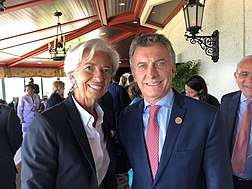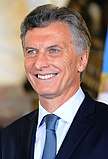2018 Argentine monetary crisis
The 2018 Argentine monetary crisis was a severe devaluation of the Argentine Peso, caused by high inflation, an increase in the price of the United States dollar at local markets, and other domestic and international factors. As a result of it, the presidency of Mauricio Macri requested a loan from the International Monetary Fund.

Background
The presidency of Cristina Fernández de Kirchner ended in 2015, and the new president Mauricio Macri sought to change many of the abnormal aspects of the economy of Argentina left behind by Kirchner. The Central Bank of Argentina's reserves were depleted; inflation was over 30 percent, although the widely discredited National Institute of Statistics and Census of Argentina (INDEC) provided a lower figure. The country had the highest tax rates in history, but the government budget balance had an eight-percent deficit. There had been a sovereign default since 2001, and a conflict existed with hedge funds. Tight currency controls had been in place since 2011. Since Argentina is a developing country, a global drop in commodity prices reduced trade revenue.[1]
One of Macri's first economic policies was the removal of currency controls, allowing Argentinians to freely buy and sell foreign currencies. Argentina has had a floating exchange rate since then, with intervention from its central bank,[2] and the Argentine peso was devalued by 30 percent.[3] Another early policy was the removal of export quotas and tariffs on corn and wheat.[4] Tariffs on soybeans, Argentina's most lucrative export, were reduced from 35 to 30 percent.[5] He also ended the national default.[6] This measures did not lower unemployment neither inflation, and growth was still weak.[7] However, the modest economic recovery was enough to allow a victory at the 2017 midterm elections, surpassing Kirchner in the Buenos Aires province by a wide margin.[8]
Growing problems
On December 28, 2017, the Central Bank of Argentina together with the Treasury announced a change of the inflation target. This was seen by the market as a relaxation of the monetary policy. In 2018, the economy took a turn for the worse. Inflation continued to be a problem, with a rate of 25% in 2017, second only to Venezuela in South America and the highest rate in the G20.[9] The Central Bank attempted to reduce it to 15%, but these efforts failed.[10] The international trade, which had a surplus in the previous year, gave a deficit. A drought reduced the production of soy, the country's principal export, ranking among the world's worst natural disasters in 2018.[11] The Federal Reserve of the United States increased interest rates from 0.25% to 1.75% and then 2%. This caused investors to return to the United States, leaving emerging markets. The effect, a raise in the price of the United States dollar, was modest in most countries, but it was felt particularly strongly in Argentina, Brazil and Turkey.[12][9] Despite the high interest rates and the IMF support, investors feared that the country might fall into a sovereign default once again.[9] Those factors led to a dramatic increase of the price of the US dollar in Argentina. The Central Bank increased the interest rate to 60%, but could not keep the price low.[13]
IMF loan
Macri announced on May 8 that Argentina would seek a loan from the International Monetary Fund (IMF). The initial loan was $50bn, and the country pledged to reduce inflation and public spending.[9] Federico Sturzenegger, the president of the Central Bank of Argentina, resigned a week later, alongside much of its senior staff. Macri replaced him with Luis Caputo, and merged the ministries of treasury and finances into a single ministry, led by Nicolás Dujovne.[14] The Turkish currency and debt crisis caused yet another increase on the price of the dollar. The tariffs on soy exports were restored, as a result of the crisis. Caputo resigned for personal reasons, and Guido Sandleris was appointed as president of the Central Bank.[15] The IMF expanded the loan with an extra 7 billion U.S. dollars, the largest loan in IMF history. In exchange, the Central Bank would operate on the price of the dollar only when it surpassed certain requirements. The national budget for 2019 reduced the deficit, which was a 2.6 percent of GDP in 2018, to zero, and estimated that inflation would decrease from 44% to 23%. This budget was approved by the Congress, despite of demonstrations and Kirchnerite rejection.[16]
In late 2019, a Kirchnerite government was elected again. The new government has refused to take the remaining $11 billion of the loan, which means that it is not obliged to adhere to the IMF conditions.[17]
References
- Benedict Mander and Daniel Politi (20 January 2016). "Macri raises hopes for Argentina's economic renewal". Financial Times. Retrieved 18 February 2017.
- Politi, Daniel (16 December 2015). "President Mauricio Macri lifts Argentina's capital controls". Financial Times. Retrieved 17 February 2017.
- "Argentina to relax foreign exchange controls". BBC. 17 December 2015. Retrieved 17 February 2017.
- "Argentina's Macri scraps corn and wheat export quotas". Reuters. 29 December 2015. Retrieved 18 February 2017.
- "Argentina delays soy export tax cut to 2018 amid budget shortfall". Reuters. 3 October 2016. Retrieved 18 February 2017.
- Bob Van Voris (13 April 2016). "Argentina Wins Court Ruling Letting Bond Sale Proceed". Bloomberg. Retrieved 13 April 2016.
- Bremmer, Ian (21 October 2016). "Argentina's Mauricio Macri on the Challenge of Change". Time. Retrieved 18 February 2017.
- Hugh Bronstein, Cassandra Garrison (October 22, 2017). "Macri's coalition sweeps Argentina's mid-term vote". Reuters. Retrieved March 14, 2019.
- "Argentina asks IMF to release $50bn loan as crisis worsens". BBC. August 30, 2018. Retrieved March 11, 2019.
- "Argentina raises interest rates to 40%". BBC. May 4, 2018. Retrieved March 18, 2019.
- Fernando Massa (December 26, 2018). "La sequía en la Argentina, entre los 10 fenómenos climáticos más destructivos del año" [The drought in Argentina, among the 10 most destructive climate events of the year] (in Spanish). La Nación. Retrieved March 8, 2019.
- "Why US rates have a global impact". BBC. June 13, 2018. Retrieved March 11, 2019.
- "Argentina raises rates as peso plummets". BBC. August 30, 2018. Retrieved March 11, 2019.
- Patrick Gillespie and Carolina Millan (June 14, 2018). "Luis Caputo Replaces Sturzenegger as Argentina Cenbank President". Bloomberg. Retrieved March 11, 2019.
- "Argentina names Sandleris as new central bank chief". Reuters. September 25, 2018. Retrieved March 11, 2019.
- "Argentine Senate Approves Austerity Budget for IMF Deal". Voice of America. November 15, 2018. Retrieved March 11, 2019.
- Grigera, Juan. "Argentina debt crisis: IMF austerity plan is being derailed". The Conversation. Retrieved 4 February 2020.
